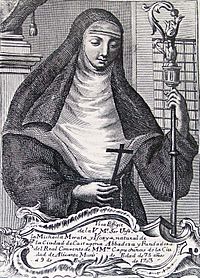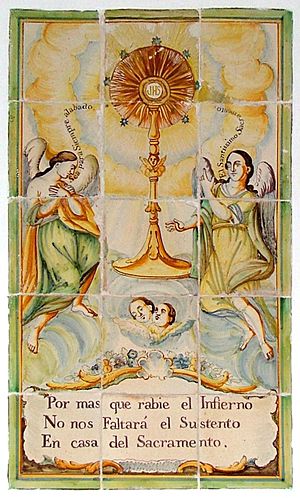Úrsula Micaela Morata facts for kids
Quick facts for kids Ursula Micaela Morata |
|
|---|---|

Sister Ursula Micaela Morata
|
|
| Venerable | |
| Born | 21 October 1628 Cartagena, Spain |
| Died | 9 January 1703 Alicante, Spain |
| Venerated in | Roman Catholic Church |
| Feast | – |
Ursula Micaela Morata was a special kind of nun called a mystic. She was born in Cartagena, Spain, on October 21, 1628. She later started a convent for Capuchin Poor Clares nuns in Alicante, Spain. She passed away in Alicante on January 9, 1703.
Contents
Early Life and First Spiritual Experience
Ursula was the youngest of thirteen children. Her family was quite wealthy. Her father, Marco Aurelio Morata e Iscaya, was an Italian knight. Her mother, Juana Garibaldo, was also of Italian background. Sadly, both her parents died when Ursula was only three years old. Her older sister, Sebastiana, then took care of her.
When Ursula was four, she had her first amazing spiritual experience. This happened when she was very sick with smallpox and almost died. She later wrote about it:
I felt like I was unconscious for about 24 hours. The joy my soul felt during that time is impossible to describe. I was in a huge, bright, divine light. Even though I didn't see any specific things, my mind and senses enjoyed it so much. I thought I was already in heaven.
This experience started her journey into a deeper religious life. She learned about prayer, fasting, and giving up things (called mortification). Through these practices, she had more spiritual experiences. Her sister also taught her to read and write, which was unusual for girls at that time.
Becoming a Nun
In 1647, Ursula made her religious vows (special promises to God) at a convent in Murcia. She chose the name Micaela when she became a nun.
A terrible sickness called the plague spread through Murcia in 1648. Sister Ursula Micaela bravely helped care for the sick people. Later, in 1651 and 1653, the Segura river flooded. The nuns had to leave their convent and find safety on a nearby mountain. During this time, Sister Ursula Micaela went through a difficult spiritual period. It's called the "dark night of the soul," which many mystics describe. In 1652, her confessor (a priest she talked to about her faith) asked her to write down her life story.
Growing in Faith
In 1653, after her "dark night of the soul" ended, she had another powerful experience. It was similar to what Saint Teresa of Ávila described. She felt a burning sensation in her heart, which she believed was from an angel.
I saw an angel with a fiery dart. He pushed it into my heart. The pain and fire I felt were so strong, it seemed to go into my bones, and I fainted. But the angel kept me from getting hurt. I spent an hour feeling joy and suffering that I can't explain, except to say I was burning with divine love.
Sister Ursula Micaela had many other special experiences. These included visions (seeing things that weren't physically there), locutions (hearing voices), and even miracles. She was especially known for bilocation, which meant she could appear in two places at once, sometimes even in other countries! She also had the gift of prophecy, meaning she could predict future events. Because of this, people, including King Charles II of Spain and John of Austria the Younger, asked her for advice. She even wrote letters to them.
In 1661, she was chosen to be a counselor and secretary for her group of nuns.
Starting a Convent in Alicante
In 1669, people started planning to build a new convent for the Capuchin Poor Clares in Alicante. It was a difficult process, but the convent finally began in 1672. At first, the nuns lived in a temporary house that wasn't very suitable. So, work began on building a proper convent and church. People in Alicante donated money, and John of Austria the Younger and King Charles II also helped pay for it. The building was finished in 1682. The convent was named "Triumphs of the Blessed Sacrament," inspired by one of Sister Ursula's visions.
Sister Ursula Micaela served as the vicaress (a leader, like a deputy abbess) of the convent until 1699. Then, she was chosen to be the abbess (the head nun) and held that position until she died. She stopped writing her autobiography in 1684, so these later parts of her life are not in her book.
Death and Steps Towards Sainthood
After two years of being sick, Sister Ursula Micaela died on January 9, 1703, when she was 75 years old. She was so well-known and respected for her sanctity (holiness) that her body was displayed in the church for six days. Her body remained incorrupt, meaning it did not decay. It stayed warm and flexible. Because of this, her body was not buried. In 1742, a bishop named Juan Elías Gómez de Terán found her body still intact. He ordered it to be placed in a special box without being buried. Her body has been kept this way ever since and is still incorrupt and flexible today.
Because of Sister Ursula Micaela's reputation for holiness, steps were taken to consider her for beatification (the first step to becoming a saint). This process began in 1703. However, important documents were lost in fires during wars. Still, her autobiography, 24 letters, and other stories about her life survived. A new official investigation for her beatification started on October 11, 2006, and finished on June 11, 2009.
Images for kids
See also
 In Spanish: Úrsula Micaela Morata para niños
In Spanish: Úrsula Micaela Morata para niños



